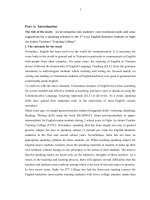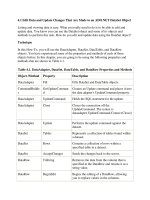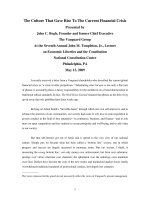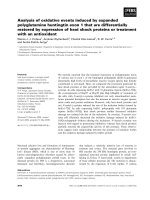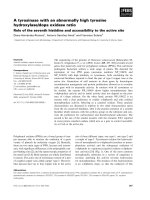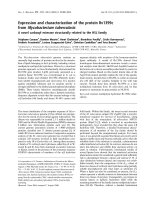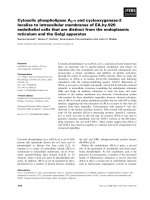Authoring and Generating Health-Education Documents That Are Tailored to the Needs of the Individual Patient doc
Bạn đang xem bản rút gọn của tài liệu. Xem và tải ngay bản đầy đủ của tài liệu tại đây (109.51 KB, 12 trang )
In Anthony Jameson, Cécile Paris, and Carlo Tasso (Eds.), User Modeling: Proceedings of the Sixth International Con-
ference, UM97. Vienna, New York: Springer Wien New York. © CISM, 1997. Available on−line from .
Authoring and Generating Health-Education Documents
That Are Tailored to the Needs of the Individual Patient
Graeme Hirst
1
, Chrysanne DiMarco
2
, Eduard Hovy
3
, and Kimberley Parsons
2
1
Department of Computer Science, University of Toronto, Canada
2
Department of Computer Science, University of Waterloo, Canada
3
Information Sciences Institute, University of Southern California, U.S.A.
Abstract. Health-education documents can be much more effective in achieving patient
compliance if they are customized for individual readers.For this purpose, a medical record
can be thought of as an extremely detailed user model of a reader of such a document.
The HealthDocprojectis developingmethodsfor producinghealth-information and patient-
education documents that are tailored to the individual personal and medical characteristics
of the patients who receive them. Information from an on-line medical record or from a
clinician will be used as the primary basis for deciding how best to fit the document to the
patient. In this paper, we describe our research on three aspects of the project: the kinds
of tailoring that are appropriate for health-education documents; the nature of a tailorable
master document, and how it can be created; and the linguistic problems that arise when a
tailored instance of the document is to be generated.
1 The Value of Tailored Health-Education Documents
Health-education and patient-information brochures and leaflets are used extensively in clinical
settings for many purposes:
– To educate patients about a particular medical condition and its management: Treatment
choices for breast cancer: The surgery decision; Living with diabetes.
– To tell them how to follow a medical regimen, prepare for a medical procedure, or man-
age recovery: Getting ready for your bowel surgery; Instructions for patients following
hysterectomy.
– For general health education: About smoking and pregnancy.
The HealthDocproject is supportedby a grant from TechnologyOntario, administeredbythe Information
Technology Research Centre. Vic DiCiccio was instrumental in helping us to obtain the grant, and
has been invaluable in subsequent administration. The other members of the HealthDoc project have
contributed to the work described here, especially Steve Banks, Phil Edmonds, Mary Ellen Foster,
Bruce Jakeway, Jon Litchfield, Daniel Marcu, Peter Vanderheyden, Leo Wanner, John Wilkinson, and
Susan Williams. Victor Strecher and Sarah Kobrin kindly discussed details of their research with us. We
are grateful to Dominic Covvey, Brigitte Grote, Manfred Stede, Dietmar R¨osner, John Bateman, and the
patient-educationcommitteesofourpartnerhospitals—SunnybrookHealthSciencesCentre(Universityof
Toronto), MassachusettsGeneral Hospital (Boston), and Peel Memorial Hospital (Brampton, Ontario)—
for helpful advice, insightful discussions,and other contributions.
108 G. Hirst et al.
Recent experiments have shown that such health-education documents can be much more effec-
tive if they are customized for individual readers in accordance with their medical conditions,
demographic variables, personality profile, or other relevant factors. For example, Strecher and
colleagues sent unsolicited leaflets to patients of family practices on topics such as giving up
smoking (Strecher et al., 1994), improving dietary behaviour (Campbell et al., 1994), or having
a mammogram (Skinner, Strecher, and Hospers, 1994). Each leaflet was tailored to the recipient,
taking into account such characteristics as reasons for smoking or belief in the efficacy of mam-
mography; this information had been asked of each patient in an earlier survey. In each study, the
tailored leaflets were found to have a significantly greater effect on the patients’ behaviour than
generic leaflets had upon the behaviour of patients in a control group.
However, in these experiments a ten-minute interview was required with each patient to elicit
the information necessary for tailoring the document. This amount of effort is not, in general,
practical. Nor can this problem be avoided by na¨ıvely assuming that patients will just go Web
surfing to seek out the health information that they need, volunteering their demographic or
medical profiles to some on-line tailoring system.
1
On the contrary, much health education must
be initiated by the clinician in response to the patient’s medical situation, and the information
must generally be presented on paper for the patient to refer to later. Fortunately, in such clinical
situations, much of the information that is needed for tailoring health-education material is
available in the patient’s medical record. Indeed, a medical record can be thought of as an
extremely detailed user model for (potential) readers of health-education documents.
This paper describes research undertaken in the HealthDoc project, which is developing
text-generation methods for producing health-information and patient-education material that
is tailored to the personal and medical characteristics of the individual patient receiving it.
Information from an on-line medical record or from a clinician will be used as the primary
basis for deciding how best to fit the document to the patient; but reader models derived from
other sources, such as interviews or surveys, could also be used. Moreover, while the project is
concentrating on the production of printed materials, much of the research will also be applicable
to the creation of tailored Web pages and interactive, hypertext-like health-education systems
that we and others are developing (e.g., DiMarco and Foster, 1997; Cawsey, Binsted, and Jones,
1995; Buchanan et al., 1995).
The structure of the HealthDoc system is shown in Figure 1. The major components will be
described as we discuss our research in the sections that follow, concentrating on three aspects of
the project: the kinds of tailoring that are appropriate for health-education documents; the nature
of a tailorable master document, and how it can be created; and the linguistic problems that arise
when a tailored instance of the document is to be generated. We assume the following model for
use of the system:
Master documents. Each tailored brochure on a particular topic is produced from a master
document on that topic, which has been created by a professional medical writer, using an
authoring tool that we will describe in Section 4 below. The master document contains all the
information, including illustrations, that might possibly be included in any individual brochure,
along with annotations as to the conditions under which each piece of information is relevant.
The nature of the master document will be described below in Section 3.1.
1
For the few patients who do, companies such as MicroMass Communications Inc. have produced some
tailorable health-education ‘magazines’; see />Authoring and Generating Tailored Health-Education Documents 109
TSL
of content
Selection
SPL
repair
Sentence
formatting
Realization
and
Master
document
TSL
Patient’s
medical record
Authoring
tool
TSL
Text
Medical writer
Figure 1. Generation of a tailored document by the HealthDoc system. Boxes with heavy lines repre-
sent processes, and boxes with light lines represent sources of information; the arrows represent flow of
information.
Dimensions of tailoring. A HealthDoc brochure may be tailored in accordance with informa-
tion about the individual patient: both the selection of content and the manner of expression of
that content may be determined by the patient’s medical conditionand their personal and cultural
characteristics (see Section 2.1 below).
HealthDoc in the clinical setting. In clinical use, HealthDoc will have access to the on-line
medical records of patients. When the clinician wishes to give a patient a particular brochure
from HealthDoc, she selects it from a menu of master documents, and specifies the name of the
patient to whom it is to be given; in addition, she may offer, or be asked to provide, information
to supplement that which the system will find in the patient’s record.
HealthDoc will then generate a version of the document appropriate to that patient. It may be
printed directly, or it may be generated to a file for a word processor so that the clinician may edit
it as desired before it is printed. The final document will be attractively laid out and formatted,
and possibly run off on pre-printed stationery.
2
2
The creation of a complete system as just described is well beyond the current scope and resources of
the HealthDoc research project. We are concentrating on authoring and sentence repair, and therefore
110 G. Hirst et al.
2 Tailoring Patient-Education Material
2.1 Classes of Patient Characteristics
A HealthDoc brochure may be tailored for an individual patient. The selection of content of
the brochure and manner of expression of that content may be determined by both the patient’s
medical conditionand any otherpersonaland culturalcharacteristics that mighteither be included
in their medical record or available from the clinician.
Patient data. The simplest kind of tailoring is inclusion of simple numerical or alphabetic
data from the patient’s record, such as the name of the patient or of a prescribed medication—in
effect, filling in the blanks in a template (Reiter, 1995). Template-filling is straightforward, and
independent of other kinds of tailoring. Where we speak below about tailoring by the creation or
inclusion of pieces of text, it is to be understood that these pieces might actually be not complete
text but rather templates that are to be further customized by filling with the appropriate data.
Patient’s medical condition. Tailoring by medical conditionentails choosing what to say and
not say in the document, in accordance with the patient’s diagnosis, physical characteristics (such
as age and gender), and medical history. For example, a brochure on living with diabetes may
includeinformation on how diabetes interacts with the patient’s other known medical conditions,
such as heart disease. When several medical conditionsinteract, the choice of what to include and
exclude can become quite complex. For example, the tailoring of a brochure advising a patient
on the benefits and risks of hormone-replacement therapy needs to take into account a large
number of interacting factors in her medical history and that of her family. In such cases, tailored
documents will be of particular utility.
Patient’s culture, health beliefs, and other personal characteristics. Tailoring by patient
characteristics involves the choice of both form and content. Many health communication studies
have shown that the ‘same’ message often needs to be framed or presented in very different ways
in order to be communicated most effectively and most persuasively to different people; indeed,
what may be persuasive to one person can actually reduce compliance in another (Monahan,
1995). In health education, individual and cultural differences in health beliefs, perception of
and attitude to risk, and level of education are among the factors that must be considered when
tailoringamessage toan individual(Masi, 1993,;Kreps andKunimoto,1994).Forexample, health
messages that attempt to arouse high amounts of fear are effective on people with low anxiety,
but less so on people with high anxiety (Hale and Dillard, 1995); similarly, anti-drug messages
are more effective when matched to the individual’s degree of need for sensation (Donohew,
Palmgreen, and Lorch, 1994).
Characteristics that are of particular interest to us at this stage of the project include locus of
control (the degree to which the patient regards herself as being ‘in charge’ of her health), ability
or desire to read technical detail, and the degree to which appeals to authority in the presentation
of information are persuasive to the patient. For more discussion, see DiMarco, et al. (1995).
other parts of the system—i.e., the user interface for the clinician, the software interface to the on-
line medical-records system, and the module for document layout, formatting, and printing—are only
simple demonstration prototypes. To avoid a commitment to any of the emerging standards for electronic
medical records and the interchangeof healthinformation, we usea fictionalmedical databasein our own
idiosyncratic format. Implementation with any particular system of on-line medical records will require
the adaptation of our query format to that of the system.
Authoring and Generating Tailored Health-Education Documents 111
2.2 What’s in the Medical Record?
When a medical author creates a HealthDoc text that is to be tailored in one or more of the
ways described above, he or she must know what information is likely to be present in a patient’s
on-line medical record, or must at least make assumptions as to what information is available. (An
electronic medical record may contain free text or scanned documents in addition to structured
data; thus the information required might be present and yet not readily available. The extraction
of information from heterogeneous electronic medical records is a research problem in itself.)
And present-day systems are unlikely to offer the kinds of non-clinical information that will
often be important in tailored health education, such as culture, level of education, or locus of
control. We believe that as electronic medical records start to become electronic health records
in the not-too-distantfuture, this kind of information will become more readily available. In any
case, HealthDoc will query the clinician user for any characteristic of the patient that it cannot
obtain from the on-line record. The medical writer is thus free to use any patient characteristic in
tailoring that he or she wishes, while considering that it would be a burden on the clinician if too
many characteristics cannot be found in the on-line record.
Regardless of what information a medical records system offers in principle, the information
might not, in practice, be available for the particular patient in question, neither from the system
nor the clinician. The writer must therefore always consider what the default action should be
when some characteristic of the reader is unknown. The default could be to include selections for
all possible values of the characteristic, or to use instead a distinct, more-generic selection; or
a default value for the characteristic might be assumed. For example, in a brochure on diabetes,
if it is not known whether a patient has the insulin-dependent or non–insulin-dependent form,
one would probably choose to give information on both. But one would probably not include
informationon the interaction of diabetes with a rare or unusual medical conditionunless it were
known for certain that this was relevant to the particular patient.
3 Representing a Tailorable Document
3.1 Finding an Appropriate Level of Abstraction
As explained above, a master document is a specification of all the information that might
be included in a brochure on a particular topic, along with annotations indicating what is to
be included when. We now discuss the nature of this master document and the problems of
combining selections from it.
In an AI-heavy approach, the elements of the master document would be pieces of a language-
independent structure in some knowledge representation (‘KR’) formalism, which would be
selected for content, as appropriate for the particular patient, but not form. These elements would
then have to pass through some complete language-generation system that would decide how to
organize and express the content, given information about the form best suited to the patient’s
personalcharacteristics. This approach iselegant and language-independent,butisnot yet closeto
being possible, even with state-of-the-art techniques, for domains as complex as those of interest
here.
On the other hand, Strecher and colleagues created the tailored texts that they used in their
experiments simply by building a large set of simple snippets of text that were included or
112 G. Hirst et al.
excluded as appropriate for both the content and form of a patient’s brochure. This method is
straightforward, but it requires that an extremely large number of bits and pieces of text be
available; Strecher and colleagues found thatthe creation and management of the large number of
text fragments involved became extremely difficult (Victor Strecher and Sarah Kobrin, personal
communication).
Moreover, the assembly of such bits and pieces suffers from the obvious problem that the
resultingdocumentmightnotbecoherentorcohesive,orattheveryleast,notstylisticallypolished.
It might be thought that the snippets of text could be constructed, or alternative expressions of the
same idea be writtenwhere necessary, so thatall possibleselections wouldresult in a well-formed
document; indeed, Strecher and colleagues attempted to do essentially this. However, they found
it extremely difficult to achieve, even for their fairly simple document (Victor Strecher and Sarah
Kobrin, personal communication); it would surely be quite impossible for complex documents,
unless the granularity were extremely coarse, thereby increasing the number of distinct elements
required. In the limit, one would not tailor the text at all, but simply store thousands of distinct
documents, each pre-written for every single combination of possibilities—a situation that is
quite impractical.
Our approach, therefore, is to use neither a KR formalism nor snippetsof text, but an abstract,
albeit language-dependent, text specification language, TSL, which we will describe in Sec-
tion 3.2 below. This language expresses not only the content of the document and the conditions
under which each element is to be selected for an individual patient, but also information that
assists a subsequent process of generating coherent, well-polishedtext. Selections from this doc-
ument are made for both content and form, as in the text-snippet approach, but are automatically
post-edited—‘repaired’— for form, style, and coherence. We will discuss the nature of these
‘repairs’ in Section 5 below. Because the repairs take place upon the abstract representation, and
are guided by the additional information that it contains, the process is much simpler than would
be required for revision of an assemblage of text snippets.
We regard this use of a master document as a new approach to natural language generation,
in which generation from scratch is avoided. Generation by selection and repair uses a partially
specified, pre-existing document as the starting point. The approach is discussed at greater length
by DiMarco, Hirst, and Hovy (1997).
3.2 Text Specification Language
Text Specification Language, or TSL, is the language used to represent master documents in
the HealthDoc system. TSL not only expresses the content of the master document but also
includes annotations on each element of that content (both textual and non-textual, at all levels of
documentgranularity),givingthecircumstances underwhichthe element isto beselected for use.
TSL annotations can also provide information—coreference links and rhetorical relations—that
guides the repair of the selected text. An example of a TSL representation of a sentence is shown
in Figure 2.
TSL represents a sentence both in English and in the sentence plan language SPL. The
latter is used by the Penman text generation system (Penman Natural Language Group, 1989,;
Bateman, 1995) that is incorporated into HealthDoc (see Section 6 below).
3
An SPL expression
3
TSL can actually accommodate multiple representations of a sentence. For example, our WebbeDoc
project (DiMarco and Foster, 1997) uses TSL with sentences marked up in HTML.
Authoring and Generating Tailored Health-Education Documents 113
Figure 2. Example of TSL representation of a sentence.
is an abstract specification of a sentence, which Penman can convert to thecorresponding surface
form. This permits expression of the content of the document. These basic SPL structures are
augmented with information for selection and repair. An example of an annotation for selection
may be seen in the slot named in Figure 2; the sentence will be selected if the
patient has high cholesterol, either insulin-dependent or non–insulin-dependent diabetes, and is
to receive a minimum of technical detail in the document.
Other annotationsare used to guidelater repairsto thetext. Coreference linksjointwoormore
references to a single object that occur in different parts of the document. A link also indicates
the kind of reference: definite, indefinite, generic, or intensional, and so on. Thus, it will always
be known if two different sentences refer to the same thing, and pronominalization can occur
114 G. Hirst et al.
accordingly (see Section 5 below). For example, the coreference information in the slot
in Figure 2 indicates that , representing the reference to heart disease, is a specific reference
that is coreferential with , which is mentioned in some other sentence. The other elements
in the list represent the other two references in the sentence, i.e., to high blood cholesterol levels
and to the risk of heart disease.
Rhetorical relations are cohesive relationships between sentences, such as cause, effect,
elaboration, and so on. All such relationships between sentences in the document are recorded
in the TSL, so that explicit discourse connectives can be used in the text where appropriate (see
Section 5). For the example shown in Figure 2, the rhetorical relations would be listed at a higher
level in the TSL and might look like this:
4 Authoring a Tailorable Document
Master documents may be based on the natural-language text of pre-existing health-education
material, or they may be created from scratch (or some combination of the two). Either alternative
requires a human and an authoring tool.
The creator of a master document would normally be a professional medical writer, who will
need to understand the nature of tailored and tailorable texts, but who should not be assumed
to have any special knowledge or understanding of TSL or the innards of HealthDoc. The
authoring tool, therefore, should be no more difficult for the writer to use than, say, the more-
sophisticated features of a typical word processor. The text is therefore written in English, and
semi-automatically translated toTSL (see below). (The English source text is retained in the TSL
for use in subsequent authoring sessions—for example, if the document is updated or amended.)
It is the writer’s job to decide upon the basic elements of the text, the rhetorical and corefer-
ential links between them, and the conditions under which each element should be included in
the output. The elements of the text are typed into the authoring tool, and are marked up by the
writer with links for cohesion and coreference and with conditions for inclusion. The conditions
for inclusion are, of course, queries on the medical record of the patient for whom a tailored copy
is to be produced.
Figure 3 shows a snapshot of the authoring tool in use (Parsons, 1997). The sample text
shown is part of a section about health risks in diabetes, from a brochure about thiscondition.The
left-hand portion of the screen, labeled Selection Criteria,contains a list of the patient conditions
that the author is using to specify the selection of pieces of text. The right-hand portion of the
screen contains a window on the text of the master document. Each box in the view contains
a piece of text and the inclusion conditions for that piece of text. Groups of boxes represent
mutually-exclusive pieces. The rhetorical relations between sentences are represented by arrows
drawn between the related boxes. Using the mouse, the author specifies the two boxes that are
related. A window containing a list of possible rhetorical relations appears; the relations are
colour-coded, so when the author chooses a relation from the list, an arrow is drawn between
the two boxes, its colour indicating the relation that was specified. Coreference relations are also
colour-coded. Each reference to the same object or concept (e.g., heart disease) is specified by
the author by highlightingthe reference and clicking with the mouse. A window that contains the
Authoring and Generating Tailored Health-Education Documents 115
Figure 3. A screen from the authoring tool.
lists of coreference links pops up, and the author specifies the list that the current object should
be added to. The reference changes colour to match those with which it is coreferential (e.g., all
references to heart disease might become blue).
After the document has been written, the text is semi-automatically translated into SPL. This
is essentially a process of parsing, but the resultant structures are (annotated) SPL expressions
116 G. Hirst et al.
rather than parse trees. Whenever an ambiguity cannot be resolved, the writer is queried in an
easy-to-understand form. The process is described in detail by DiMarco and Banks (1997).
5 Tailoring a Document
We nowconsider the kindsof textual repairs or post-editingthat might beneeded after material in
the TSL master document has been selected for a particular patient. We will show the examples
in English, but it is to be understood that the process is taking place on the underlying TSL
representation.
In general, selecting material from pre-existing text and then editing it to recover coherence
and cohesion involves a wide range of problems in sentence planning. Our sentence planner
uses a blackboard architecture in which individual repair modules communicate and resolve
their conflicts with one another. The architecture is described in greater detail by Hovy and
Wanner (1996). Four repair modules are being developed in the present phase of the project: for
coreference, fordiscoursestructuringand rhetoricalrelations,foraggregation,and forconstituent
ordering. Here, we will give examples of the first two.
Repair—Coreference. Coreference repairs include decisions as to when a reference should be
pronominalized. Suppose, for example, we have a master document that contains the following
two sentences (in TSL, of course):
(1) People with respiratory disorders have a high risk of developing Glaumann’s disease.
(2) People with respiratory disorders should take immediate action to quit smoking.
The italicized noun phrase in each arises from a coreference link to the same object in the list
of references. So if, upon selection, these two sentences turned up in close proximity, the first
occurrence of the reference wouldbe marked for realization as a full noun phrase, and the second
would be marked for pronominalization:
(3) Peoplewith respiratory disordershave a high riskof developing Glaumann’sdisease. They
should take immediate action to quit smoking.
Repair—Rhetorical relations. If two selected sentences are marked as being rhetorically
related, the repair module will consider making the cohesive relationship between the sentences
explicit. For example, if the sentences in the example above were marked as evidence and
conclusion, then the word therefore might be inserted:
(4) Peoplewith respiratory disordershave a high risk of developing Glaumann’sdisease. They
should therefore take immediate action to quit smoking.
6 Realization and Formatting
The final specifications for the repaired text, represented in SPL, are passed to the realization
stage, which uses KPML (Bateman, 1995), a descendant of Penman, to generate an appropriate
surface form in English. A formatter then lays out the text attractively and adds headings and
illustrationsfor final printing.
Authoring and Generating Tailored Health-Education Documents 117
7 Conclusion
In the HealthDoc system, we are tailoring health-education and patient-information documents
by using the medical record as a model of the reader that allows us to select appropriate elements
from a master document encoded in TSL. A subsequent process of ‘repair’ ensures that the
selections form a coherent, linguistically well-formed document. We have adopted a model of
patient education that takes into account patient information ranging from simple medical data
to complex cultural beliefs. A number of important issues for research in tailorable health-
communication documents and their authoring have been raised during the first phase of the
project.
The basis for tailoring health information to a given individual. Although the need for
tailored health communication has been recognized, there has as yet been little research on how
information may be conveyed most effectively to a known individual to motivate a change in their
behaviour.(The present state of the artis represented by Kreps and Kunimoto, 1994,; and Maibach
and Parrott, 1995.) In the next stage of the project, identifying critical examples of variations in
text by medical condition and by culture and health beliefs will be an important task.
Authoring tailorable documents. We have not yet worked with any real-life medical writers,
and hence have not tested our assumptions as to whether medical writers would be able to design
tailorable documents with our authoring tool as we have conceived it—or even in principle.
Language dependence. Both the authoring tools and the processes that refine the selections
from themaster document are necessarily language-dependent, so at present HealthDoc is limited
to English,ourworking language.It is hoped that in the longterm it will be possible to add master
documents in other languages, such as German, Spanish, and French, for which the necessary
grammars and lexicons are being developed in other projects in natural language generation.
Unfortunately, there is little or no applicable research in the languages—Chinese, Vietnamese,
Khmer—that are the greatest problems for the hospitals with which we are collaborating.
4
Development of the master document. Our consideration of how patient-information docu-
ments should be initially written and then tailored has led us to propose the use of a master
document. However, the nature of the master document may need to be redesigned as we begin
to address questions of stylistic and pragmatic tailoring, such as the incorporation of persuasive
effects. The master document is a set of TSL fragments, but it lacks the information needed to
do the kind of whole-scale revision that would be needed for this level of pragmatic tailoring.
We expect to augment TSL with additional fields for discourse-level, semantic, and stylistic
information.
References
Bateman, J.A. (1995). KPML: The KOMET–Penman multilingual linguistic resource development envi-
ronment. Proceedings, 5th European Workshop on Natural Language Generation, Leiden, May 1995,
219–222.
4
All three of our partner hospitals serve large, multi-ethnic, multicultural communities, and intercultural
and multilingual communication—indeed, the practice of multicultural health care in general—is a
continuing problem for them.
118 G. Hirst et al.
Buchanan, B., Moore, J.D., Forsythe, D.E., Carenini, G., Ohlsson, S., and Banks, G. (1995). An intelli-
gent interactive system for delivering individualized information to patients. Artificial Intelligence in
Medicine, 7:117–154.
Campbell, M.K., DeVellis, B.M., Strecher, V.J., Ammerman, A.S., DeVellis, R.F., and Sandler, R.S. (1994).
Improving dietary behavior: The effectiveness of tailored messages in primary care settings. American
Journalof Public Health, 84:783–787.
Cawsey, A., Binsted,K.,andJones,R. (1995). Personalizedexplanationsfor patienteducation.Proceedings,
5th EuropeanWorkshopon Natural LanguageGeneration, Leiden, May 1995, 59–74.
DiMarco,C.andBanks,S.(1997).Usingsubsumptionclassificationonastylistichierarchyin themulti-stage
conversion of natural language text to sentence plans. In preparation.
DiMarco, C. and Foster, M.E. (1997). The automated generation of Web documents that are tailored to the
individual reader. Proceedings,AAAI Spring Symposium on Natural LanguageProcessingon the World
Wide Web, Stanford University, March 1997.
DiMarco, C., Hirst, G., and Hovy, E. (1997). “Rewriting is easier than writing”: Generation by selection
and repair in the HealthDoc project. In preparation.
DiMarco, C., Hirst, G., Wanner, L., and Wilkinson, J. (1995). HealthDoc: Customizing patient informa-
tion and health education by medical condition and personal characteristics. Workshop on Artificial
Intelligence in Patient Education, Glasgow, August 1995.
Donohew,L.,Palmgreen,P.,andLorch,E.P.(1994).Attention,needforsensation,andhealthcommunication
campaigns. American Behavioral Scientist, 38:310–322.
Hale, J.L. and Dillard, J.P. (1995). Fear appeals in health promotion campaigns:Too much, too little, or just
right? In Maibach and Parrott 1995, 65–80.
Hovy, E.H. and Wanner, L. (1996). Managing sentence planning requirements. Proceedings, ECAI-96
Workshop‘GapsandBridges’:NewDirectionsin PlanningandNaturalLanguage Generation,Budapest,
August 1996.
Maibach, E. and Parrott, R.L. (1995). Designing health messages:Approaches from communication theory
and public health practice. Thousand Oaks, CA: Sage Publications.
Masi, R. (1993). Multicultural health: Principles and policies. In Masi, R., Mensah, L., and McLeod, K.A.,
eds., Health and cultures: Exploring the relationships. Volume I: Policies, professional practice and
education. Oakville, Ontario: Mosaic Press, 11–22.
Monahan, J.L. (1995). Thinking positively: Using positive affect when designing health messages. In
Maibach and Parrott 1995, 81–98.
Parsons, K. (1997). An Authoring Tool for Customizable Documents. M.Math. thesis, Department of Com-
puter Science, University of Waterloo, forthcoming.
Penman Natural Language Group (1989). The Penman primer, The Penman user guide, and The Penman
reference manual. Information Sciences Institute, University of Southern California.
Reiter, E. (1995). NLG vs. templates. Proceedings, 5th EuropeanWorkshopon Natural LanguageGenera-
tion, Leiden, May 1995, 95–105.
Skinner, C.S., Strecher, V.J., and Hospers, H. (1994). Physicians’recommendationsfor mammography:Do
tailored messages make a difference? American Journal of Public Health, 84:43–49.
Strecher, V.J., Kreuter, M., Den Boer, D J., Kobrin, S., Hospers, H.J., and Skinner C.S. (1994). The effects
of computer-tailored smoking cessation messages in family practice settings. The Journal of Family
Practice, 39:262–270.
